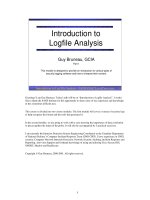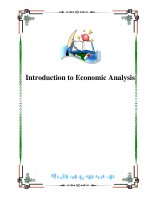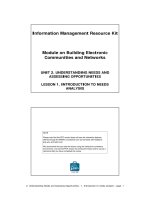Vol 5 introduction to fundamental analysis
Bạn đang xem bản rút gọn của tài liệu. Xem và tải ngay bản đầy đủ của tài liệu tại đây (472.72 KB, 10 trang )
INTRODUCTION TO
FUNDAMENTAL ANALYSIS
Editor Matthew Carstens
WWW.INVESTING.COM
FOREX TRADING GUIDE
1
INDEX
The investing.com education center was created in order to serve as a guide to
the novice trader over all the essential aspects of foreign exchange, in a fun and
easy-to-understand manner.
1. General Understanding
Basic Assumptions........................................................................................................ 3
The Necessity of Fundamental Analysis......................................................................... 3
Accessibility................................................................................................................... 4
2. Economic Indicators
Lagging Indicators......................................................................................................... 5
Leading Indicators......................................................................................................... 5
Major Economic Indicators............................................................................................ 5
Implications................................................................................................................... 7
Expecting the Unexpected............................................................................................. 7
Data Points.................................................................................................................... 8
Economic Indicators and Trading................................................................................... 8
2
INTRODUCTION TO FUNDAMENTAL ANALYSIS
WWW.INVESTING.COM
General Understanding
General Understanding
The Primary objective of this guide is to equip you with the prerequisite knowledge
needed to better understand some of the driving forces in the Forex market,
and help educate you on a number of the most popular Fundamental Analysis
data points, and tools that can help you make better informed trading decisions.
Fundamental Analysis refers to analyzing the political, economic and fiscal events
that may influence currency prices.
These may consist of reports regarding unemployment, economic & monetary
policies, economic growth rates, and even the current or future outlook of inflation
in a country. Before trading in the markets, it is essential that Forex traders have
a least a general understanding of the forces that can affect the world’s currency
markets.
Basic Assumptions
Fundamental Analysis in the currency markets has two main assumptions:
• Long term time frames. Fundamental Analysis is mainly used to evaluate very long
term trends. Think of currencies more like a moving cruise ship, there is usually a
longer process to get that ship heading in one direction, to start moving in another
direction for an extended periods of time.
• Currency trading is a relationship between one countries currency to another’s. So
a news event or economic data point that is positive or negative for one specific
currency may not behave the same when compared to another currency. Simply
put, a seemingly weak currency could show strength when compared with an even
weaker one.
The Necessity of Fundamental Analysis
Fundamental news announcements on a specific country’s health can be like popping a
sugar pill as it can really ramp the energy up for market participants. Especially in this day
in age when news is at our finger-tips, and up to the second, massive amounts of money
are moved from one asset to another in a flash. So a savvy trader needs to be aware
of what type of events may occur, when they may happen and of course how they can
prepare for them ahead of time.
Fundamental Analysis then, can be tied nicely together with Technical Analysis so a
trader can discern not only when and perhaps why large price movements may occur
(Fundamental), but at what price should they try to enter and exit at (Technical).
WWW.INVESTING.COM
INTRODUCTION TO FUNDAMENTAL ANALYSIS
3
General Understanding
Accessibility
Most online brokers provide access to most major scheduled fundamental news
announcements, though Investing.com provides you almost all major data points in
multiple countries with our Economic Calendar. We even provide you with a very easy
way to understand each event’s importance with our “Imp.” column, so you can quickly
scan and find those events that tend to produce the most market action.
Below is a screen shot of what Investing.com provides you:
Source: www.investing.com/economic-calendar»
4
INTRODUCTION TO FUNDAMENTAL ANALYSIS
WWW.INVESTING.COM
Economic Indicators
Economic Indicators
There are a number of different kinds of indicators provided by a government
or academic institution to help in evaluating the country health. these indicators
are normally released or published on a weekly, monthly or quarterly basis. they
represent dependable data points on an economy’s health and are tracked by just
about everyone in any financial or investment market.
Economic indicators on the whole can be divided into:
Lagging Indicators
Indicators released AFTER the economy has already begun to follow a certain trend.
These types of indicators are used to validate changes in the economy.
Leading Indicators
Indicators released whose changes PRECEDE changes in the economy. These types of
indicators are used to forecast changes in the economy.
Major Economic Indicators
Interest Rates
Interest rate changes have a dramatic effect on capital in and outflows into a country’s
currency. So much so, that this may be the most important data point to remember.
Generally speaking, a high interest rate offered by a country attracts foreign investment
in an effort to earn more interest on their capital. This results in an increased demand for
that country’s currency and continued price appreciation. Likewise, a lowering interest
rate environment helps in devaluing a country’s currency as those wishing to earn more
interest income on their funds look for better rates elsewhere.
Employment Situation /Unemployment Rate
The Unemployment Rate is a measure of the percentage of the total labor force that is
unemployed but actively seeking employment and willing to work. A high percentage
indicates weakness in the labor market.
WWW.INVESTING.COM
INTRODUCTION TO FUNDAMENTAL ANALYSIS
5
Economic Indicators
Nonfarm Payrolls
The Nonfarm Payrolls measure the change in the number of employed people during
the last month of all non-farming businesses. Nonfarm payroll comes out the first Friday
of every month for the U.S. and is usually a significant event. Within the Nonfarm payroll
numbers are specifics on average hourly earnings, specifics on what sectors are increasing
or decreasing jobs, and of course revisions from previous month’s numbers.
NOTE: Do not underestimate the impact this can have on the markets.
Gross Domestic Product (GDP)
This is the broadest measure of economic activity and is a key indicator for the economy’s
health. The percent changes in GDP shows the growth rate of the economy as a whole.
Trade Balance
A measurement of the difference in worth between exported and imported goods (exports
minus imports). This is the largest component of a country’s balance of payments. Export
data can give refection on the growth of the nation. Imports provide an indication of
domestic demand.
CPI
This is a measurement of the changes in the price of goods and services. The CPI
measures price change from the perspective of the consumer. It is a key way to measure
changes in purchasing trends and inflation in the nation.
PPI
This is a measurement of the average change in selling prices received by domestic
producers of goods and services, a measurement of the cost of producing goods. The
PPI measures price change from the perspective of the seller.
Retail Sales
This is a measurement of the sales of retail goods over a stated time period.
PMI
This is a measurement of the economic health of the manufacturing sector.
6
INTRODUCTION TO FUNDAMENTAL ANALYSIS
WWW.INVESTING.COM
Economic Indicators
Housing Starts
This is a measurement of residential building construction projects begun during a specific
period of time.
Industrial Production
This is a measurement of the production output from industrial activities. It gives us a
good indicator of strength in the manufacturing sector.
Consumer Confidence
This is a measurement of the level of Confidence consumers have in the economic activity.
It is a leading indicator as it can predict the consumer spending, which is a major part in
the total economic activity.
Implications
Although as a trader you do not need to understand every minute detail of the data
that goes into each Economic Indicator, you ought to know what they are used for and
their overall relationship to a country’s economy. For instance, you should know which
indicator is used to measure the growth rate of a country’s economy and which indicator
is used for measuring the inflation rate of an economy.
This is important as not all economic indicators are treated equally. Generally speaking,
the financial markets tend to react more to a small handful of indicators, while ignoring
others which of course can change according to the economic and political circumstances
of the time. For instance, during a time of economic expansion and growth, the market
may be much more sensitive to interest rate changes in a specific country than to their
unemployment numbers.
Expecting the Unexpected
Often, the significance of this data comes not from what they measure but rather whether
or not these figures fall within the expectations of the markets at that time. If a report gives
a different picture from what the market participants and economists are expecting (the
“Forecast” which you can see in our Economic Calendar), the result will “surprise” the
market and probably result in volatile price fluctuations with potential trading opportunities
as the market adjusts itself to this new data.
WWW.INVESTING.COM
INTRODUCTION TO FUNDAMENTAL ANALYSIS
7
Economic Indicators
A word of caution though as one must not be too anxious to act whenever an economic
report does not follow the market expectations as many times the market will move in
one direction on a data point, to quickly revert back to the other direction based on the
continual flow of new information. This commonly occurs as a “revision” to the prior
month’s data which frequently happens in items such as the unemployment or Nonfarm
payroll numbers.
Data Points
Although an academic economist might appreciate the comprehensive details of the
figures that are released in an economic report, traders generally are not interested in
sifting through all that data, rather they look for headline numbers (like “unemployment is
at 8.9%”, or “Nonfarm payroll came in at 216,000”) to make an informed trading decision.
Because of this you can see price action move from one direction to the next in dramatic
fashion as there is so much money waiting to be allocated (or moved) from one asset to
another based solely on a data point.
Economic Indicators and Trading
• Always have an Economic Calendar nearby so you are up to date on any major
economic news announcement.
• Recognize which Economic Indicators are currently more sensitive than others during
this time and remember this too will change over time.
8
INTRODUCTION TO FUNDAMENTAL ANALYSIS
WWW.INVESTING.COM
Economic Indicators
Source: www.investing.com/news/economic-indicators»
• Be prepared for wild market swings by either staying on the sidelines and waiting for
the excitement to cool down or strategic by placing Stops and Limits to catch any
breakout and/or limit large potential losses.
NOTE: Novice traders get caught up in news trading because they believe they can make
a quick buck due to the sudden price movements an d soon find themselves without any
funds in their account. Trading news events is extremely dangerous business so unless
you are only risking a small portion of your funds for such an event, it is probably wise to
wait until after it occurs (and perhaps a new trend has begun) to enter. This is serious, so
read that message again if you like keeping your bank account full.
WWW.INVESTING.COM
INTRODUCTION TO FUNDAMENTAL ANALYSIS
9
Economic Indicators
Below are a few chart examples of price action during a news event.
10
INTRODUCTION TO FUNDAMENTAL ANALYSIS
WWW.INVESTING.COM









